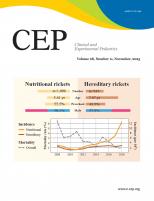Article Contents
| Clin Exp Pediatr > Volume 68(11); 2025 |
|
Abstract
Background
Purpose
Methods
Results
Conclusion
Footnotes
Conflicts of interest
B. Vogt reports grants or contracts from NuVasive/Globus and Smith & Nephew, and payment or honoraria for lectures, presentations, speakers’ bureaus, manuscript writing or educational events and support for attending meetings and/or travel from NuVasive/Globus, OrthoPediatrics, Smith & Nephew, BioMarin, Orthofix, Kyowa Kirin, and Merete, all of which are unrelated to this article. A. Frommer reports grants or contracts and support for attending meetings and/or travel from NuVasive/Globus, unrelated to this article. A. Laufer reports support for attending meetings and/or travel from BioMarin, NuVasive/Globus, and Implantcast, all of which are unrelated to this article. H. Tretow reports support for attending meetings and/or travel from NuVasive/Globus, Smith & Nephew, Orthofix, Kyowa Kirin, all of which are unrelated to this article. R. Roedl reports institutional grants or contracts from NuVasive/Globus, royalties or licenses and patents planned, issued or pending from Merete, and payment or honoraria for lectures, presentations, speakers’ bureaus, manuscript writing or educational events from NuVasive/Globus, BioMarin, Kyowa Kirin, Vereinigung für Kinderorthopädie, Forum für medizinische Fortbildung, and Infectopharm, all of which are unrelated to this article. G. Toporowski reports support for attending meetings and/or travel from NuVasive/Globus, Smith & Nephew, Orthofix, Kyowa Kirin, all of which are unrelated to this article. The other authors have nothing to disclose.
Funding
This study received no specific grant from any funding agency in the public, commercial, or not-for-profit sectors.
Acknowledgments
We sincerely thank all infants and their families for participating and trusting in this study. We also acknowledge the dedicated support of the nursing and clinical staff in the Department of Pediatric Orthopadics at University Hospital Münster for their assistance in patient care and data collection.
Author contribution
Conceptualization: BV, AD, AF, GT; Data curation: BV, AD, HT; Formal analysis: BV, AD, AF, AL, HT, RR, GT; Methodology: BV, AD, AF, AL, RR, GT; Project administration: GG, AF, AL, HT, RR, GT; Visualization: BV, AD, AL; Writing - original draft: BV, AD, GT; Writing - review & editing: BV, AD, AF, AL, HT, RR, GT
Fig. 1.

Fig. 2.

Fig. 3.

Fig. 4.

Fig. 5.







 PDF Links
PDF Links PubReader
PubReader ePub Link
ePub Link PubMed
PubMed Download Citation
Download Citation


